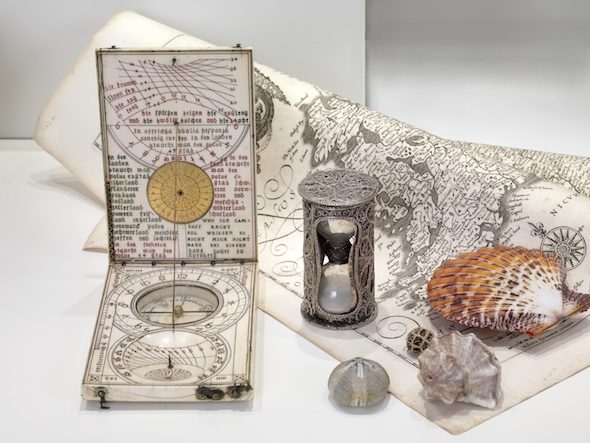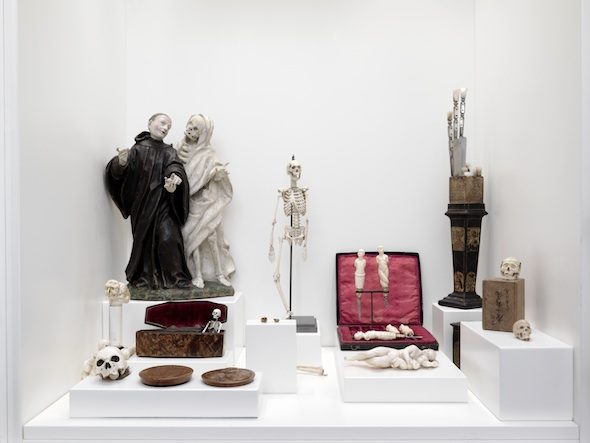Article by TL Andrews in Berlin; Friday, Dec. 18, 2015
The irony that some of the biggest attractions in European museums were stolen from the rest of the world escapes most people. Fanny-packed tourists pour in to see the bust of Nefertiti in the Egyptian Museum of Berlin, for instance, forgetting that in one sense it is an artifact; in another, it is loot. Most visitors gloss over this grand-scale pillaging because of an implicit declaration in all of the displays: a declaration that these artifacts, the bones and contraptions, the temple adornments and indeed the silver and gold, were collected in the name of science. And voila, ownership legitimised, consciences cleared.
“It is well established that art and science were highly interconnected in the Renaissance,” says Georg Laue, the curator of the latest exhibition with exotic artifacts as its focus – the Wunderkammer Olbricht in Berlin. “Science was part of art and art was frequently the product of science,” Laue elaborates. The Wunderkammer is a re-creation of the old aristocratic practise of displaying curiosities from around the world in collections. Some of the most notable were in Dresden, Copenhagen, Florence, Munich and Berlin. This one features artifacts collected by nobles between the 17th and 19th centuries.

Installation view at Wunderkammer Olbricht // Photo by Bernd Borchardt, courtesy of me Collectors Room
“The goal behind the Olbricht Wunderkammer was to give visitors an impression of the collectors’ culture in the Renaissance,” Laue says. The exhibition has certainly achieved that. It is a physical manifestation of the European gaze. It is comprised of artworks (artificiala) – things like wooden masks, necklaces made from crocodile teeth; scientific instruments (scientifica) – items used in hospitals and clinics at the time; and objects from foreign cultures (exotica). This is where things get a little uncomfortable.
It is hard to see the exhibition with its ornate treasures from around the globe and not think of Sarah Baartman. She was a South African slave who in the early 1800s was lured with the promise of fortune to London by a ship’s doctor, William Dunlop. Baartman was put on display in freak shows as the ‘Hottentot Venus’. Curious crowds ogled her body features, which European audiences were not accustomed to seeing. Her comparatively large buttocks were seen as evidence of the deeply held (scientific) belief that Africans were hyper-sexual. Later Baartman went to Paris where she experienced more ridicule and stigmatisation. When Parisians got tired of her show she was forced into prostitution and soon died at the age of 25. Upon her death, a French scientist George Cuvier made a plaster cast of her body, then removed her skeleton, brain and genitals, pickled them and displayed them in bottles at the Musee de l’Homme in Paris. Her dismembered body remained there for centuries.
It was only when Nelson Mandela became president of South Africa and called for her remains to be returned that change eventually occurred. It took the French government eight years to pass a bill authorising the repatriation. The law had to be carefully worded so as to prevent other countries from claiming the return of their stolen treasures. Imagine if every European museum were forced to return artifacts taken from other places – in many cases, the very same places governments would currently love to send refugees back to.
Two things are happening in exhibitions like this, on two different levels. On a direct level the exhibition is designed to portray people’s worldview at the time, in the terms of that time. It could be compared to writing a screenplay about slavery for instance – in order for the portrayal to be real the characters have to represent their real prejudice. They need to be able to say things like the “n word” because that is what racists back then would say. In that sense it’s easy to see why the curators simply let 17th century world-views jump out of the artworks and speak for themselves in the prejudicial idiom of the day. The Wunderkammer does that superbly.
But on another level the curators function as, and bear the responsibility of, an author. They write with the benefit of social progress over the past few centuries and they have the power to set the framework. The problem with the Wunderkammer is that on that level, the meta level, there seems to be little engagement with the European culpability in looting the world. Never mind their failure to address whether or not it is ‘right’ to hold this collection today.

Installation View at Wunderkammer Olbricht // Photo by Bernd Borchardt, courtesy of me Collectors Room
So the question arises: are exhibitions justifiable on the basis that they reveal the prejudices of people who lived long ago, without at least in some way problematising those prejudices? Every display or exhibition that deals with the Holocaust is drenched in German shame and showered in caveats, why should it be different here?
To put it another way: To what extent should curators be expected to editorialise atrocities from the past? Though the answer to that question is open for discussion, one thing is sure – no exhibition can choose not to answer it. As Elizabeth Hallam and Brian Street put it in their book Cultural Encounters, Representing Otherness: “Anthropologists are always implicated in the social and cultural processes that they describe and analyse.”
From that perspective there is a sense in which art exhibitions and the science they either celebrate or historicise are complicit in the othering of the so-called third world. As Johannes Fabian writes in Presence and Representation: “Othering expresses the insight that the other is never simply given, never just found or encountered, but made.” Exhibitions contribute to the making of the other – especially when the exoticising of cultures is at the very heart of the material, as is the case here.
Even if all the ideological issues could be waved away with a wand the concerns about ownership and the “right to portray” linger. In any court of law in any modern democracy around the world, evidence gained through wrong-doing is inadmissible. Yet art gained through subjugation is perched on our display cabinets without an ounce of compunction. And the agent capable of washing consciences so clean? Science. That is to say science and its unholy matrimony with art, which together have had the unique power to dismember and dehumanise people like Sarah Baartman for their noble ends.
The Wunderkammer Olbricht makes the point that art and science were never neutral or apolitical. They were not during the Renaissance and are not now. Perhaps we should stop pretending then.
Exhibition Info
ME COLLECTORS ROOM
Group Show: ‘Wunderkammer Olbricht’
Exhibition: Permanent Collection
Auguststraße 68, 10117 Berlin, click here for map
Writer Info
TL Andrews is a multi-media journalist based in Berlin. He produces features for radio, television and print outlets with a focus on Berlin, Germany and European themes.

























